Rocking a gravel garden in the Kuzma Garden: Portland Garden Bloggers Fling
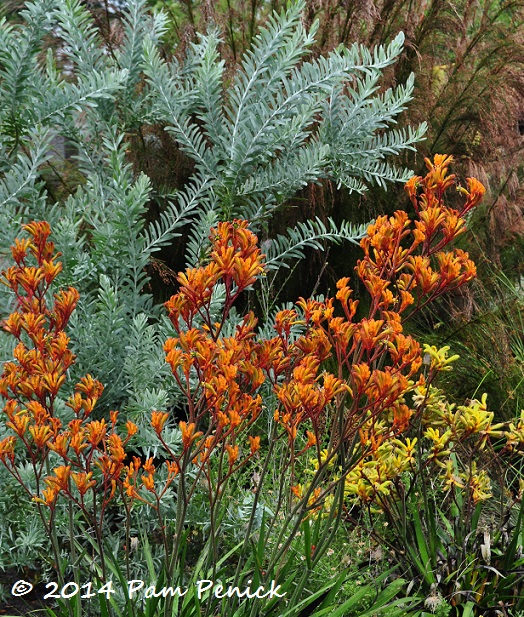
After the barely controlled excess of Floramagoria, the next garden we toured on the Portland Garden Bloggers Fling seemed, at first glance, restrained, even austere. No seating was visible aside from garden walls and steps. With the exception of a few monumental, colorful pots placed as focal points and a striking steel fountain, garden art was nonexistent. But, oh my, the plants are where owner John Kuzma lavishes his artist’s palette and experiments with an abundance of dry-climate species you wouldn’t expect to see in moist, cool Portland.
John’s suburban half-acre is one of the larger private gardens we visited, but the entry garden is modest in size. An open, gravel courtyard, wood-and-wire fence, and xeric plants like agave and nolina gave this space a very Austin look, at least to my mind. Here’s the paver path leading from the street into the fenced courtyard.
And the side entry from the driveway. A large, blue pot, left empty (such restraint!), provides a focal point from any direction.
As you enter the back garden, negative space greets you first — gravel, not water-sucking lawn. An expansive, dark-gray, gravel patio flows from the back of the house along the entire width of the lot. Bold-leaved palms, banana, phormium, and agave are planted along the margins, with silvery eucalyptus shining in the border. A straight line of black mondo grass runs like a fuzzy, black caterpillar from…
…a small, arbor-shaded patio to…
…a contemporary raised pond fed by two pipes projecting from a rusty-steel backplate.
Now you see where John’s passion lies. A dramatic foliage garden rises on terraced beds and gravelly berms behind the water feature, creating a feeling of exotic seclusion from neighboring homes, not to mention a fine view from John’s living room.
Palms, papyrus, giant cape restio (I think) — this garden is about texture, form, and bold foliage.
A smaller water feature is as simple as a lotus in a sealed, glazed pot. Mosquito dunks (available at big-box stores and independent nurseries alike) keep a still pond like this free from blood-sucking pests.
The gravel patio is largely open, but along the foundation of the house agaves and prickly pear (New World natives) mingle with Australian acacias and Mediterranean palms.
Steps lead up to an abundantly planted, almost prehistoric-looking garden. Despite its apparent lushness, John told us that his 4-year-old garden, designed by Sean Hogan of Cistus Nursery, took a hit in last December’s deep freeze.
Tammy of Casa Mariposa takes in the scene. (By the way, if you’d like to see a list of Portland Fling attendees and their blogs and locations, click here.)
This is where things really get good! Ah, kangaroo paws. How I wish I could grow you in Austin.
Spiky plants dig John’s gravelly berms, which keep them from rotting during Portland’s drizzly, gray winters.
On this large berm, John has made a trendy crevice garden for his agave collection. I’m seeing quite a few of these lately, like at Denver Botanic Gardens and, closer to home, in Shirley’s San Antonio garden.
I see a few ‘Whale’s Tongue’ agaves in there — Moby‘s cousins!
As in the front garden, John uses a big, glazed pot to create a focal point for multiple pathways entering an open space.
It looks great from every angle.
Orange kangaroo paws provide a perfect color echo amid cool-blue yucca, prickly pear, and gopher plant.
Here’s another example, with a blue pot acting as focal point for the end of a path.
More lushly planted berms
Portland has a friendly climate for green roofs, and we saw a number of them at the Fling, including this charming, sedum-planted one on a blue shed.
At the rear of the garden, a row of yuccas (Y. recurvifolia, perhaps?) was in creamy-white bloom.
Dramatic gunnera leaves
Let’s head down to the gravel patio for one last look at the raised pond and fountain.
This is a very Austin look, with the rusty metal and raw steel pipes. You’d need a metal fabricator to create this, right?
Well, I wonder. From the side I noticed that rather than a solid plate of steel, cut panels are screwed onto wooden posts to create the fountain backplate. The fountain basin itself is concrete, stained to match the steel. You’d still need someone to cut the steel plates, but this could be installed by a do-it-yourselfer, I think.
It would make a wow moment in any garden, wouldn’t it?
Up next: The romantic, wild-child, mysterious Bella Madrona, our final Fling garden. For a look back at the stunning, whimsical exuberance of Floramagoria, click here.
All material © 2006-2014 by Pam Penick for Digging. Unauthorized reproduction prohibited.


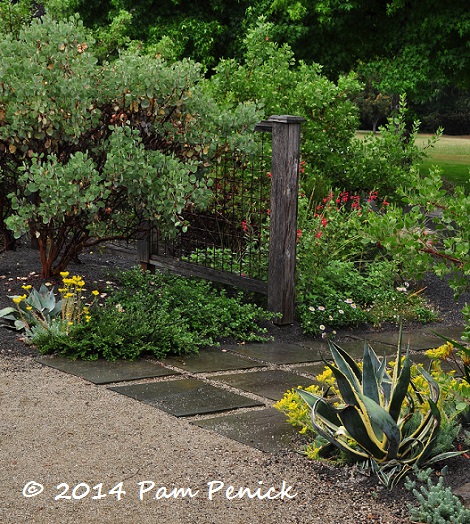
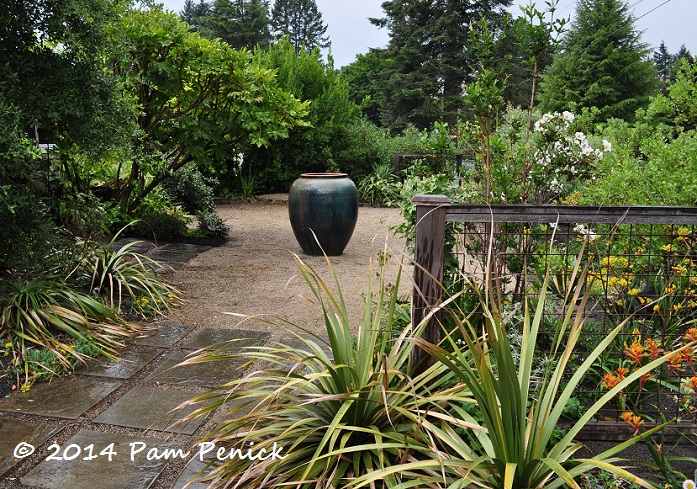
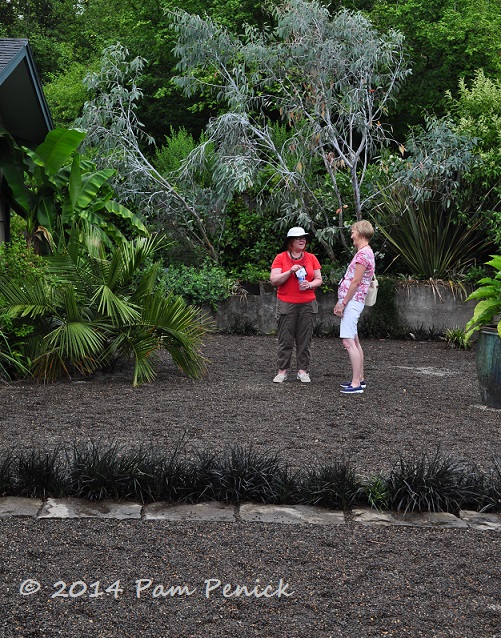
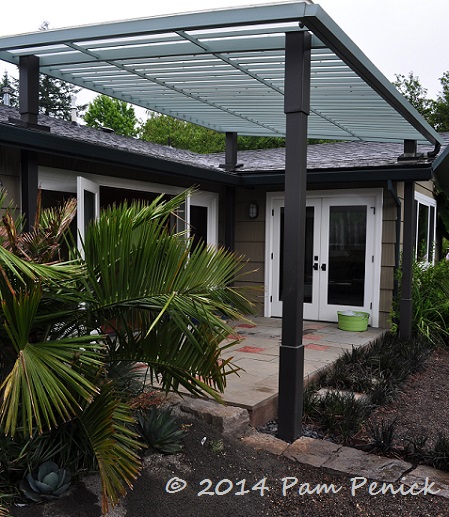
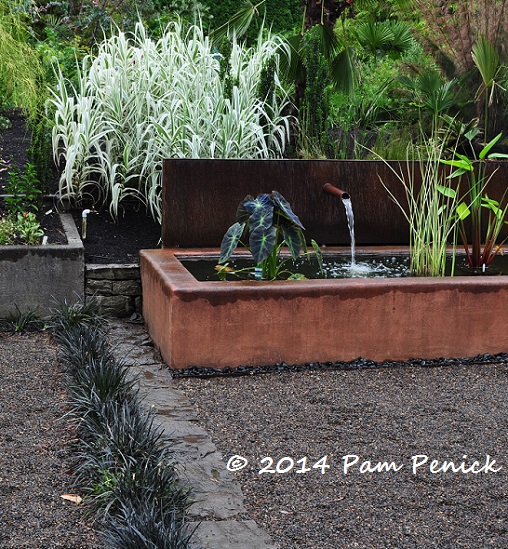
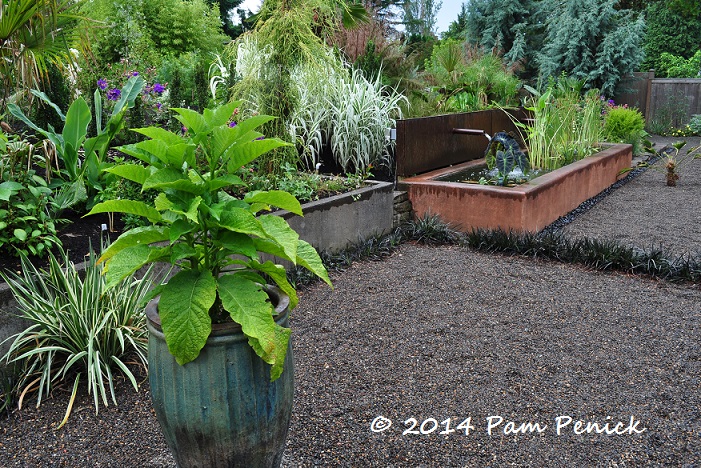
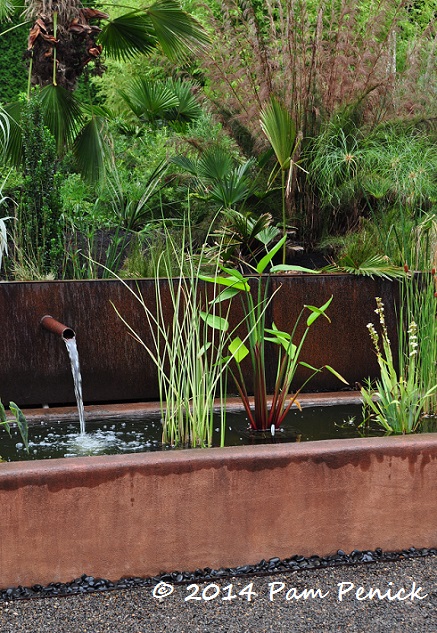
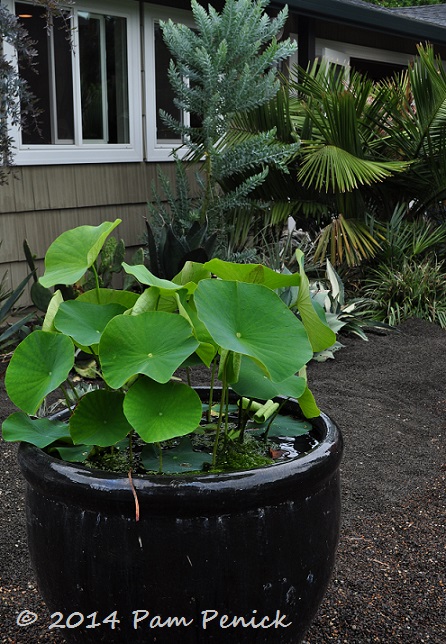
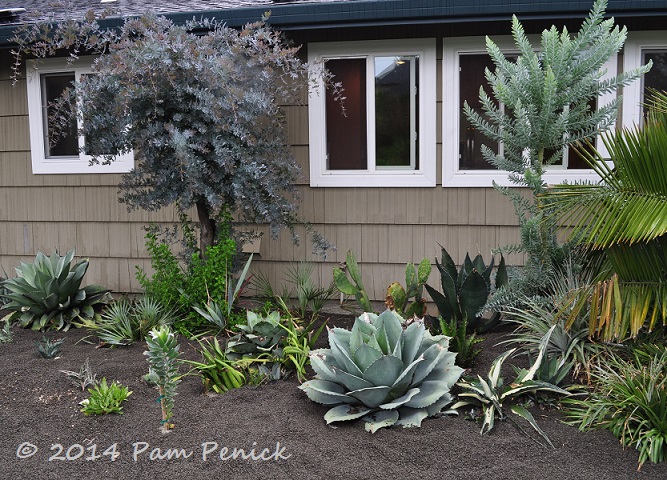
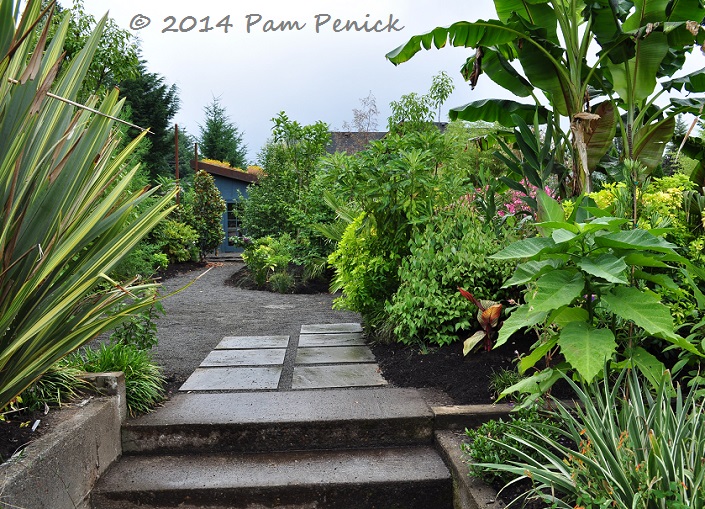
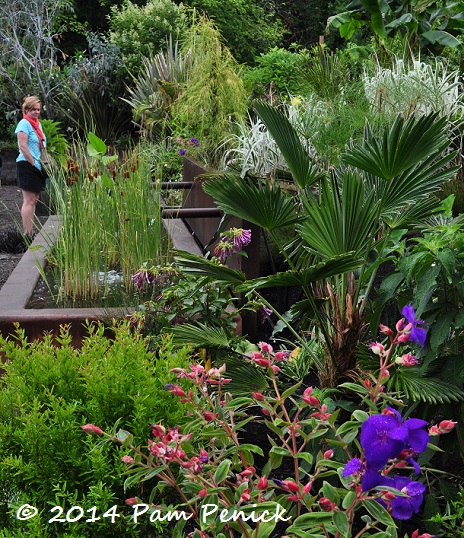
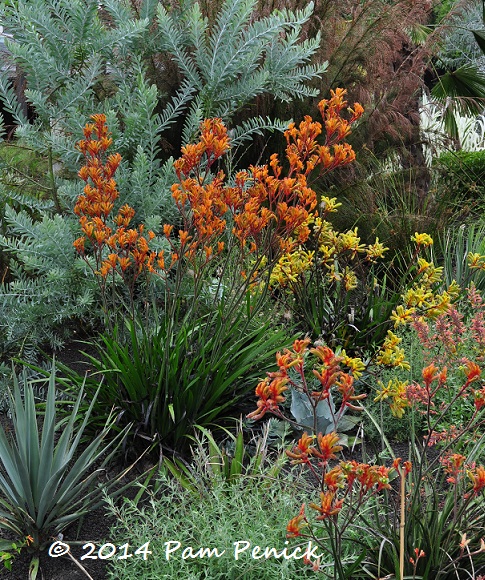
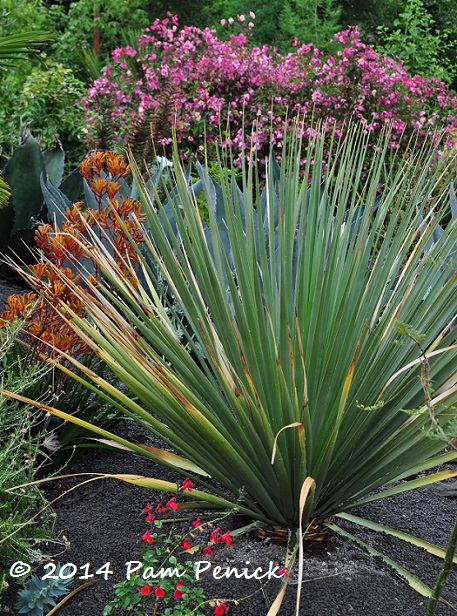
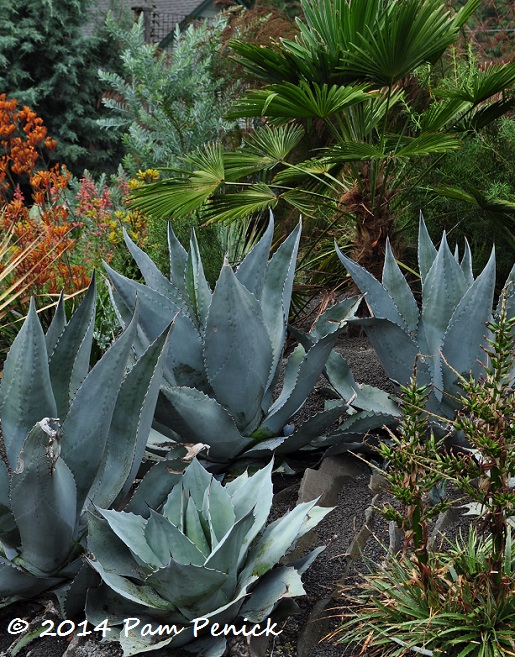
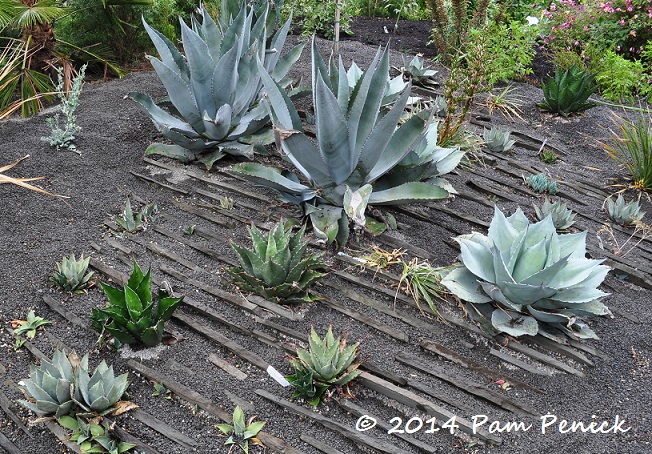
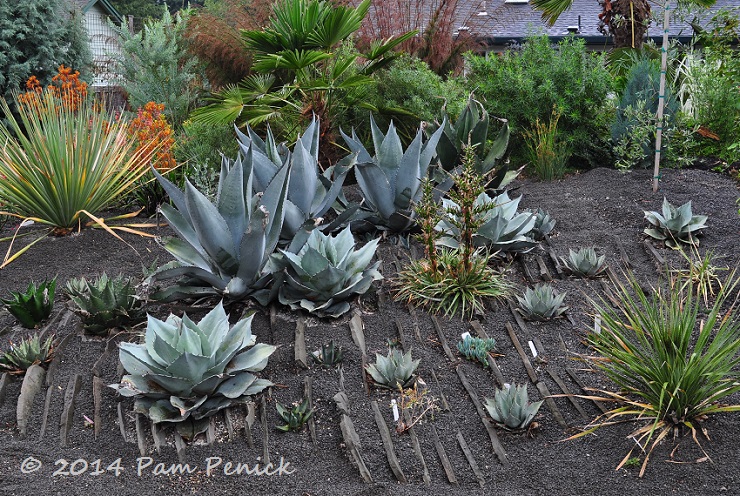
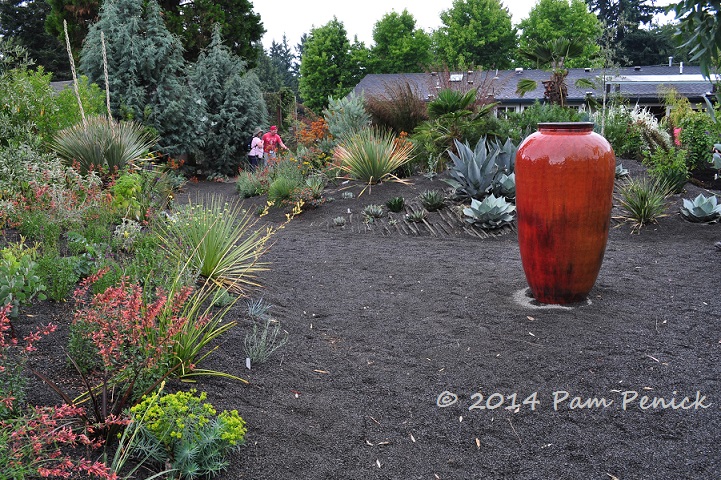
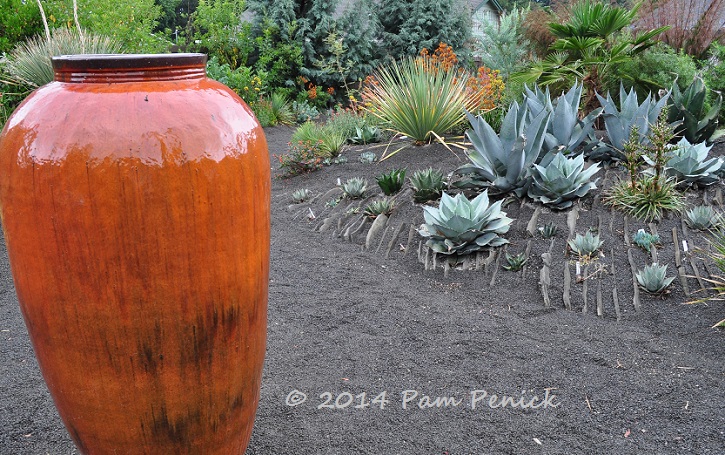
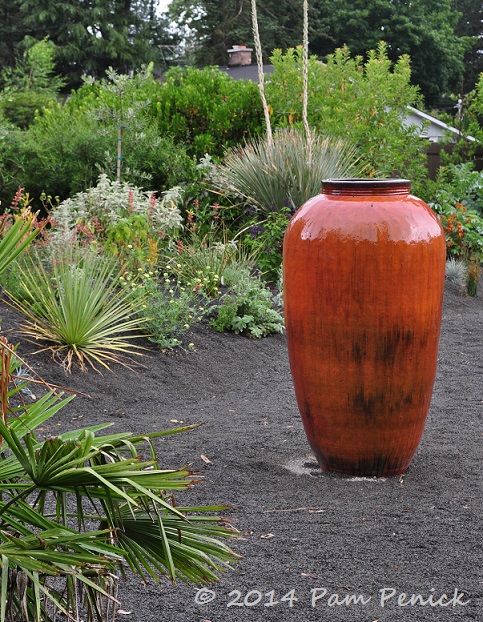
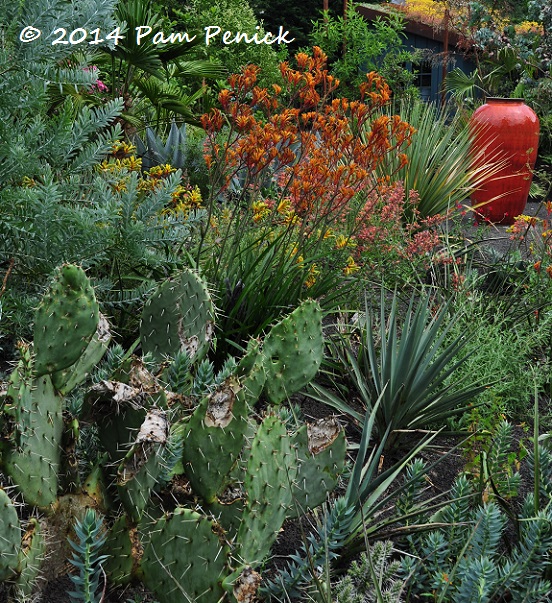
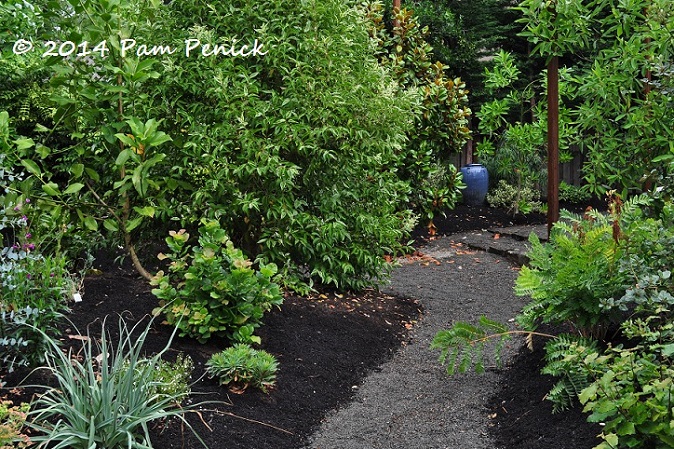
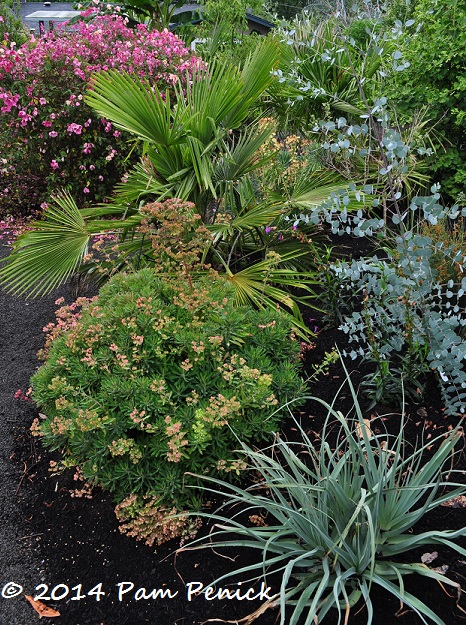
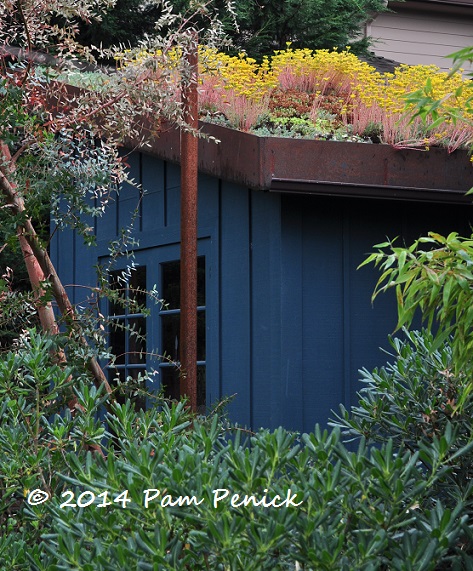
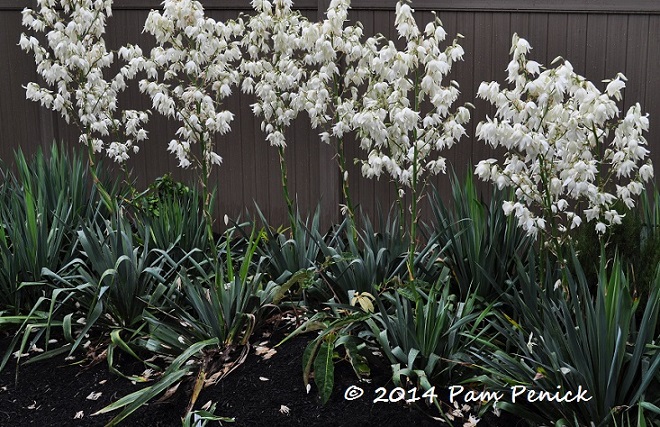
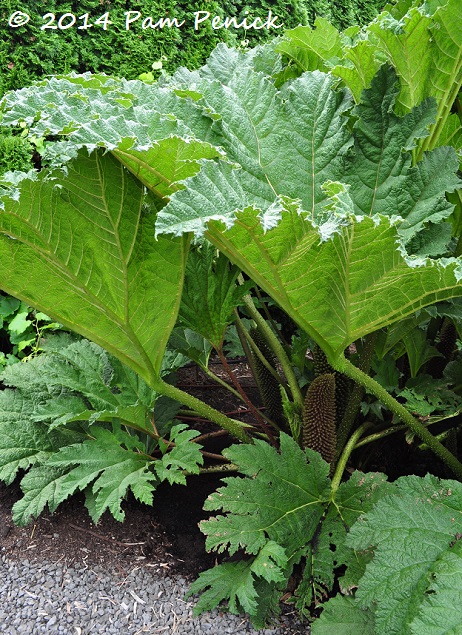
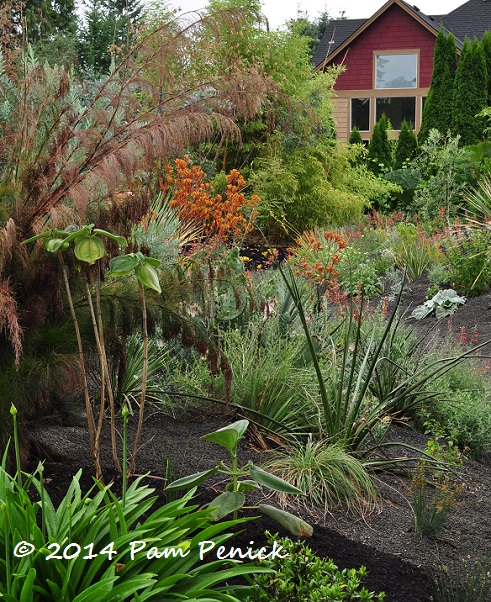
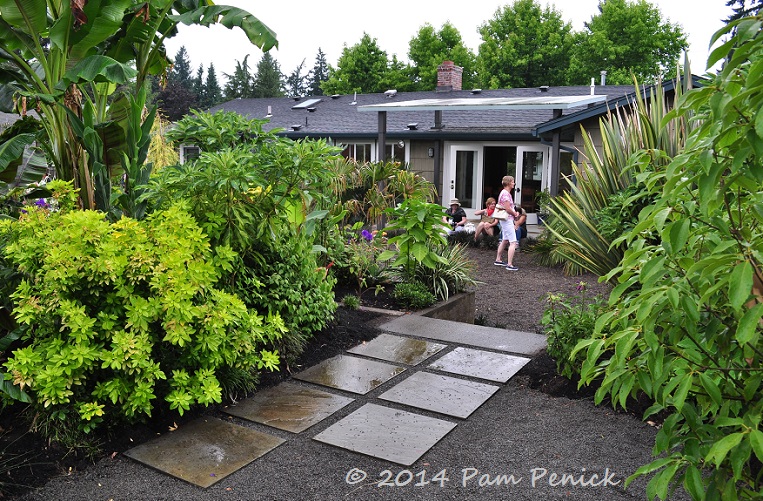
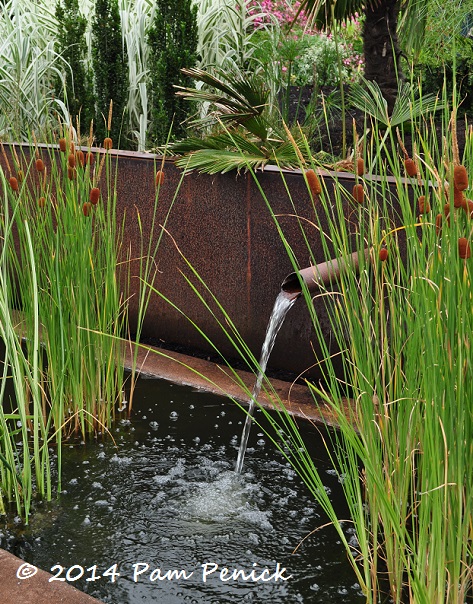
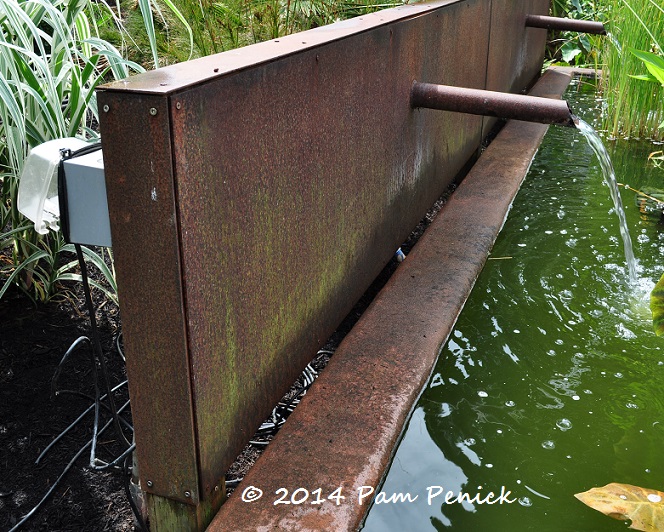
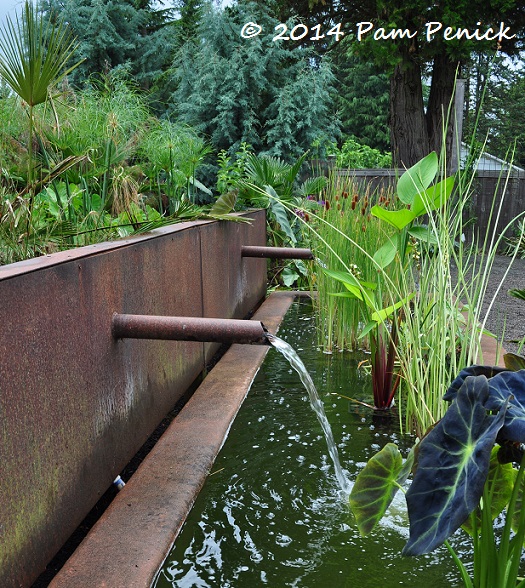
The gravel yard is quite a change from gardens you have presented. I would imagine in that rainy area gravel would keep the mud off your shoes. It is nice to see the little blooms on the shed roof. Usually those type of plantings aren’t very becoming to me. They appear all washed out, but not here. I love the black mondo rill running through the garden. Another beautiful garden in it’s own way.
Yes, although several of the other gardens had dry-garden areas. I guess when you live where you can grow anything, you do! —Pam
Oh I would love to see this garden which directly inspired my own crevice garden! Thanks for the link love and I’ve pinned your photos to my collection of crevice garden photos.
I’m enjoying the garden tours and I’ll be sure to check out the other blogs to find more on all my favorites.
I didn’t realize this was your inspiration, Shirley! So glad I could give you an updated look. —Pam
Great photos and write-up! That bold container was a gorgeous focal point that I know I shot from lots of angles–hope some of them come out as nicely as yours!
Also, much appreciate the info about mosquito dunks; had never heard of them before.
Mosquito dunks are lifesavers here in buggy Austin. I use them all the time, although if you have fish in your water feature you don’t necessarily need them, as fish love to eat mosquito larvae. However, if you use the dunks anyway, they won’t harm the fish. —Pam
John’s crevice garden just keeps getting better and better! And yes, his garden was hit very hard with our crazy cold and snow/ice last winter. The man is a genius when it comes to over-wintering borderline plants (like the acacia and kangaroo paws) but in the end mother nature had her way with a few things.
A couple of other people mentioned the lack of seating. Do you want to hear something crazy? It never even occurred to me. I remember the first time I visited I wanted to see the big open courtyard in front and the gravel space by the house in back full of people (it seemed like the perfect party garden) but I guess I’ve just thought of the garden (and house) as a work in progress and that he’d add the seating when he found the time to look for what he wanted. Now I want to ask him about that…
Mother Nature will have her way, won’t she? As for the big gravel spaces, they are perfect gathering spaces for large groups — serving the same function as a lawn, in that regard. I wondered if he had put away patio chairs to make more room for bloggers on his small, arbor-shaded patio, or whether he just never sits down! —Pam
I think you’re onto something (he just never sits down)
Like so many of us. —Pam
It seems Portland can have it all from temperate to dry gardens . This is a beautiful garden with, as you say, many ideas for those of us who garden in Texas. That water feature is fabulous. You didn’t say if John was a garden designer or just has a wonderful eye for garden design. The mention of seating is an interesting one as I recently read gardeners giving one English garden much criticism for not having seating in their garden. I am in agreement with that. Seating is a necessary part of garden design. I hope he finds the perfect pieces for his garden .
Hi, Jenny. As I mentioned in the post, the garden was designed by Sean at Cistus Nursery. But clearly John is a knowledgeable and skilled gardener, as it was in tiptop shape. —Pam
We were just looking at that tiny gray gravel at a stone yard the other day wondering how one might use it. Clearly, here is the answer. What a stunning garden and not what I would expect in Portland. Thanks for sharing and ferreting out how that water feature was made.
It wasn’t what I expected to see in Portland either, and it was different from the other gardens on the tour, which made it a fun surprise. —Pam
All those wonderful leafy textures! Reminds me of Berkeley. Yet one more reason (excuse?)to head north… its really just too dry in the Sac valley for many of them to do well.. at least, this has been my experience.
Uh-oh, Cheryl. Sounds like you’re packing your bags! 🙂 —Pam
This was a plant lovers paradise. I loves the simplicity of the hardscape. And the lone empty pots placed so perfectly to draw your eye out from the mass of plantings. I with we could get the dark gray gravel they have in Oregon. I think it must be volcanic. Fun to see this garden weeks later!
Laurin, can you get the dark-gray “Texas black” gravel in Houston, which is used frequently in Austin? It has a similar look, although it’s chunkier. —Pam
Now we know what Austin gardens might look like if we routinely got enough rain!
I’ve been coveting Shirley’s crevice garden. It is great to see the inspirational starting point closer up. That works here in Texas with or without rain.
And ooooh – the water feature is a real show stopper. I appreciate your “behind the curtains” glimpse at its construction. I have been wanting to implement a water feature for a long time but worry about how responsible that would be in our current drought situation (especially when it comes to water lost to evaporation). I suppose a shady position would help with that issue.
“Now we know what Austin gardens might look like if we routinely got enough rain!”
Yes, and a gentle, Teletubbies-style sun instead of the Death Star.
As for a water feature, I’m a big believer in introducing at least a little water into a dry garden. Christy Ten Eyck uses vessels of water in her desert gardens, calling them symbols of abundance. We need such symbols more than anyone! There are ways of doing so responsibly: place a still feature in shade, or, if choosing one with a fountain, make sure it doesn’t shoot up very high or splashily. —Pam
These unique gardens are beautiful and love the succulents! The different colors and foliage combinations John has created are amazing. Thank you for sharing!
My pleasure, Lee! —Pam
We loved this Pam, great photos and write up! Funny you mentioned about the lack of seating, neither of us noticed it! It’s such a vision and explore garden that seating never really occurred to us.
Clever with the water feature, we assumed the vessel was steel!
It’s interesting to hear from various gardeners in these comments as to whether or not they wish to see seating areas in a garden. I definitely do — and lots of them, which is why I loved JJ De Sousa’s and Linda Ernst’s gardens so much. But I still very much enjoyed John Kuzma’s less-decorated garden, especially since the plants were so wonderful. —Pam
An alternative to using Mosquito Dunks… Add Gambuzia affinis or mosquito fish to your water gardens (even the smaller water pots). They eat mosquito larvae and keep the population at bay. I have had the same “colony” in my pond for over 6 years here in Austin, through freezes and heat.
Good point, Merrideth. I have gambusia in my stock-tank pond as well. I wouldn’t have thought to add them to a pot of water as small as the one shown here, but I guess they are pretty small. —Pam